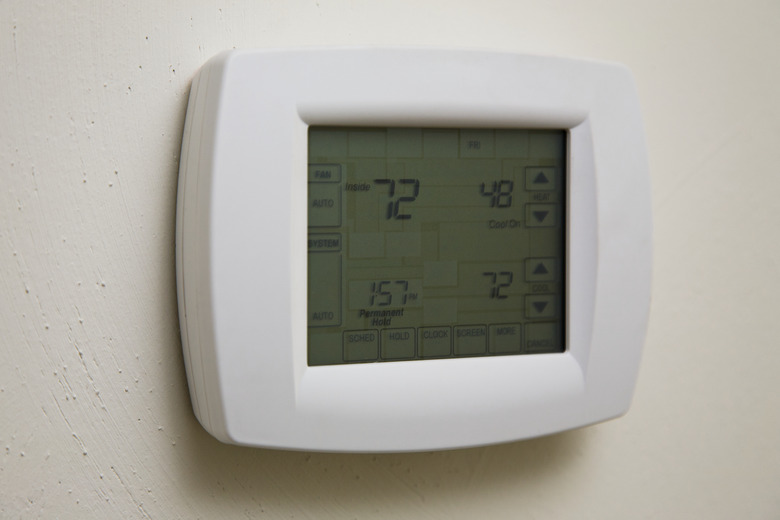Thermostat 101: All The Different Types Of Thermostats In Your Home
We may receive a commission on purchases made from links.
It will probably surprise you to learn how many different types of thermostats you have in your home. Virtually every system or appliance that controls temperature has a thermostat. Although there are many styles and designs, a thermostat is really just a type of switch that controls the on/off function of a system or appliance by means of a temperature-sensing element built into the thermostat. The purpose is to adjust (or keep) the temperature of the room or appliance to the level you choose.
If you're constantly dissatisfied with your home's temperature, or your energy usage is more than you'd like to pay for, it makes sense to learn about all the different types of thermostats in your home — especially if you plan on purchasing a new thermostat for your HVAC system.
Systems and Devices Using Thermostats
Systems and Devices Using Thermostats
Almost everyone is familiar with the wall thermostat that controls the temperature of a home's HVAC (heating-ventilation-air conditioning) system, but different types of thermostats can be found in many other appliances and devices in your home. Other than a furnace and central air conditioner, thermostats are also found on virtually all types of baseboard heaters, space heaters and room window air conditioners.
Ovens, stoves, electric frypans and other cooking appliances likely have thermostats. Your refrigerator and freezer also have different types of thermostats, and if your bathroom has a heat lamp, it probably has a thermostat too. Dishwashers, clothes washers and dryers once had rudimentary high-medium-low thermostats, but modern types often have more precise thermostats that allow for a much broader range of temperature control.
While the appearance of these thermostats varies considerably, they can all be categorized in the same way. If you understand the workings and variations of the common wall thermostat for forced-air HVAC systems, for example, you will also understand the basic workings of appliance thermostats.
Line-Voltage vs. Low-Voltage Thermostats
Line-Voltage vs. Low-Voltage Thermostats
All thermostats can be categorized as line-voltage or low-voltage thermostats. Line-voltage thermostats are usually found on electric baseboard heaters, in-wall heaters and some space heaters. They are also sometimes found on whole-house heat-pump systems, including ductless "mini-split" systems. The term "line voltage" refers to the fact that they operate on the same circuit voltage (120 or 240 volts) that powers the heater itself. The thermostat is essentially a variable switch that is part of the same circuit that brings power to the radiating or cooling coils in the electric heater or air conditioner.
On the other hand, low-voltage thermostats aren't part of the same electrical circuit that powers the heating or cooling appliance. Instead, they use stepped-down voltage, usually 24 volts, provided by a transformer that converts standard 120-volt circuit voltage to the low voltage required by the thermostat. The thermostat senses temperatures and sends low-voltage signals through fine-gauge wires to the controls on the heating or cooling unit.
Virtually all central forced-air HVAC systems operate on low-voltage thermostats, not line-voltage types. Line-voltage thermostats are more often found on electric baseboard heaters, sometimes integrated into the heater itself but more often mounted on the wall of the room.
Mechanical (Analog) vs. Digital Thermostats
Mechanical (Analog) vs. Digital Thermostats
Another basic categorization of thermostats is by the manner in which temperature is sensed and control signals are initiated — either by means of mechanical parts that move inside the thermostat or by electronic digital impulses. Many older line-voltage thermostats use a mechanical design; these thermostats are sometimes known as analog thermostats. However, most modern HVAC climate-control systems and many modern heating/cooling appliances use thermostats with digital designs. Digital controls can be used in both line-voltage and low-voltage thermostats; the presence of digital controls does not always mean the thermostat is a low-voltage model.
Mechanical/Analog Home Thermostats
The older-style mechanical/analog thermostats work by making use of the physical principle by which metals and gases expand or contract as the temperature changes. One classic mechanical thermostat is the well-known and extremely reliable Honeywell dial thermostat, which can still be found in thousands of homes. Inside this type of thermostat, room temperature is monitored by a metal coil attached to a glass vial filled with mercury — a liquid metal that conducts electricity.
The mercury vial has three wires. One wire extends to the bottom of the vial and is in constant contact with the mercury. Another wire is near the top left side of the vial, and another is near the top right. As the metal coil expands and contracts with temperature changes, it tilts the vial one way or the other. If the temperature in the room drops, the metal coil contracts, tilting the mercury vial in one direction. The mercury switch completes a low-voltage signal to the furnace, causing it to begin its heating cycle. If the temperature in the room rises, the metal coil expands, and the vial tilts in the opposite direction. The switch makes contact with the opposite wire in the mercury vial, completing the low-voltage circuit that initiates the air conditioning unit.
Some version of this expansion-contraction principle is used in every mechanical thermostat, although the mechanical workings vary considerably. Some styles use a straight bimetal strip that bends one way or the other depending on temperature changes. Other styles use a gas-filled bag that shrinks or expands as room temperature changes, opening or closing switch contacts in the thermostat.
Digital Home Thermostats
Digital thermostats work in an entirely different way using transistor boards and digital signals. Temperatures are sensed by a special kind of electronic resistor, called a thermistor, that measures room temperature by sensing differences in electrical resistance that occur when current flows at different temperatures. A tiny microprocessor registers the numerical value of this resistance, converts it to a precise temperature reading and then other transistors and programmed microchips interpret this information and send a complex series of micro voltage digital signals to the HVAC system components, telling them what to do.
Most modern low-voltage thermostats controlling whole-house forced-air HVAC systems are now digital models, but so are many line-voltage thermostats used to control electric baseboard heating and other cooling/heating systems. Within the class of digital thermostats, however, there are several variations.
Digital Thermostat Variations
Digital Thermostat Variations
Because the microprocessors and memory chips in a digital thermostat are so tiny, a great deal of information can be stored by the circuitry. While early digital thermostats did little more than the older mechanical thermostats — just in less space and more reliably — modern digital thermostats are often highly sophisticated devices that pack a surprising array of functions.
Simple Digital Thermostats
The most basic digital thermostats do little more than provide simple, automatic on/off functions, but they do it in a very compact unit that is extremely efficient and reliable. Like the older Honeywell-style low-voltage dial thermostats, most modern digital thermostats are powered by low-voltage current provided by a transformer. The temperature readings and control settings are displayed on a small LED screen on the front of the thermostat. These simple digital thermostats may also have a battery backup that allows the readings to continue displaying on the screen even if the power from the transformer is interrupted.
The simplest digital thermostats with automatic on/off functions that hold room temperature steady at whatever setting you choose are still available, though most people now opt to step up to somewhat more sophisticated digital thermostats.
Programmable Digital Thermostats
The next step in digital thermostat design was the introduction of programmable thermostats, with which a user can program a number of automatic temperature settings through an inner digital timekeeper. This allows for much greater energy efficiency since the thermostat can be set to automatically drop the temperature at night or during the day when occupants are at work or in school. The most sophisticated thermostats can allow for as many as 28 different temperature settings — four for each of the seven days of the week.
These thermostats typically have a larger LED display that makes it easier to make setting adjustments. The LED screen may occupy most of the front panel on the thermostat.
Smart Home Thermostats
A more recent innovation in digital thermostats is the so-called smart thermostat. These smart thermostats begin with a fairly sophisticated programmable design, but they then add Wi-Fi connectivity that makes it possible to monitor and adjust your home's HVAC settings from afar using a smartphone, computer or tablet device. Within the home, your phone or tablet can work as a remote control for your thermostat, and it can serve the same function when you travel by monitoring the conditions in your home and adjusting the temperature via any internet connection.
The sophistication of smart thermostats grows with each passing year. Some of these thermostats can also monitor home humidity or provide monthly energy reports, and some can be controlled via Amazon's Alexa or other voice-control systems, such as Google Assistant. Some even have remote sensors that allow you to monitor the temperature of different rooms; they balance the temperature of different rooms to run the HVAC system in a manner that provides the best overall heating or cooling. Because they are permanently connected to the internet, some of these smart thermostats even display outdoor weather conditions and forecasts.
Learning Home Thermostats
The latest generation of programmable smart thermostats are often known as "learning" thermostats. The leading brand is Nest, which has become synonymous with this type of device.
These are programmable thermostats of a special kind. Based on machine learning algorithms, Nest thermostats require a learning period of several weeks, during which you set the thermostat temperatures manually. The thermostat commits your habits to memory. Then, after the learning period is complete, the thermostat takes over the day-by-day temperature adjustments automatically. These state-of-the-art thermostats can even recognize when all family members are away from the home via phone GPS and adjust the temperature accordingly to maximize energy savings (and therefore money on your energy bills).
Thermostats for Appliances
Thermostats for Appliances
The thermostats found in heating and cooling appliances around your home all use some variation of the same types of designs used for whole-house HVAC systems, though they may look very different in the compact form necessary to fit into appliances. When the thermostat on a window air conditioner, oven, space heater, water heater or other appliance malfunctions, it may be possible to replace it yourself by researching online documentation for instructions or videos describing the process. Some thermostats, however, cannot be serviced affordably, and the entire appliance must be replaced if the thermostat fails.

